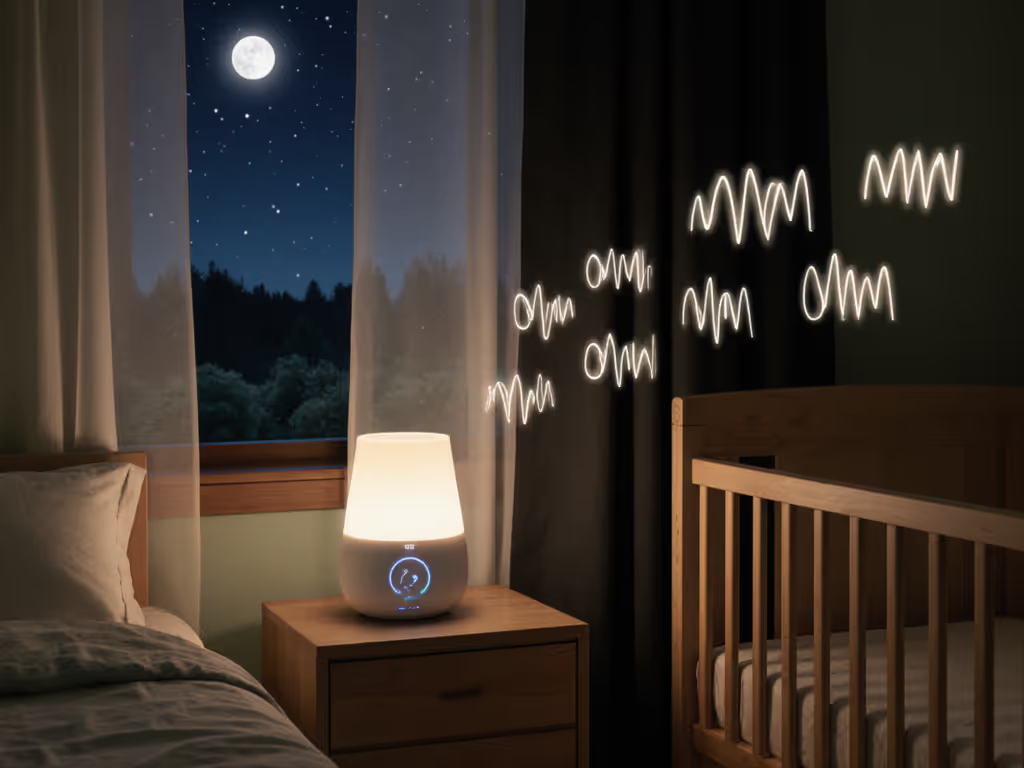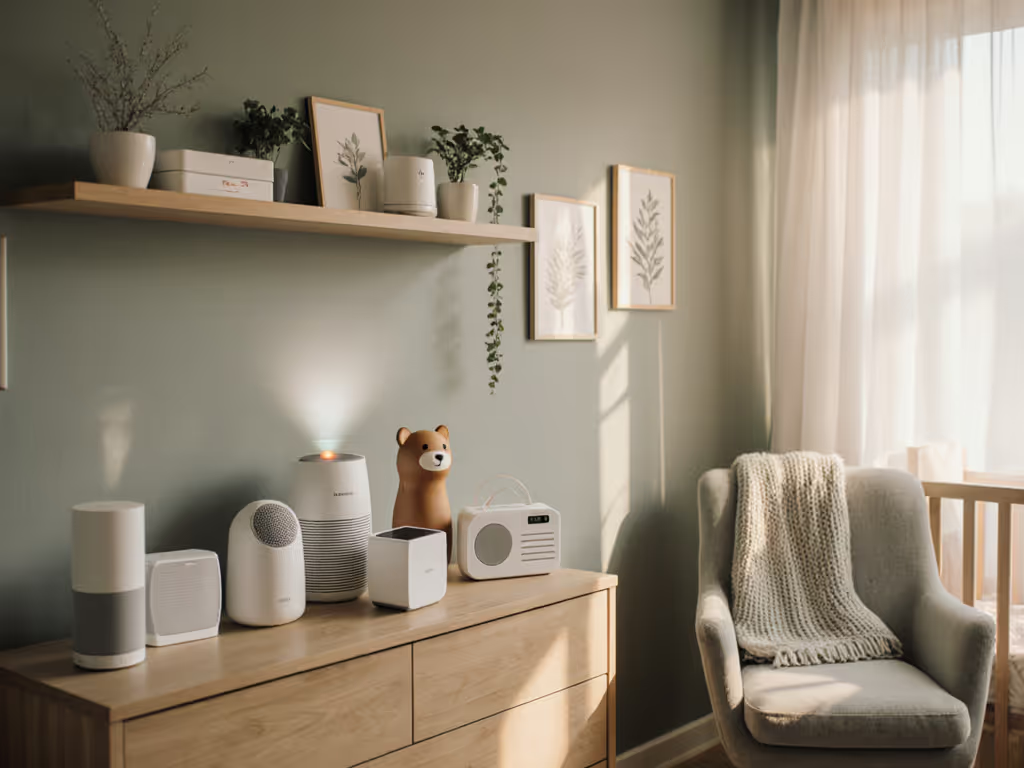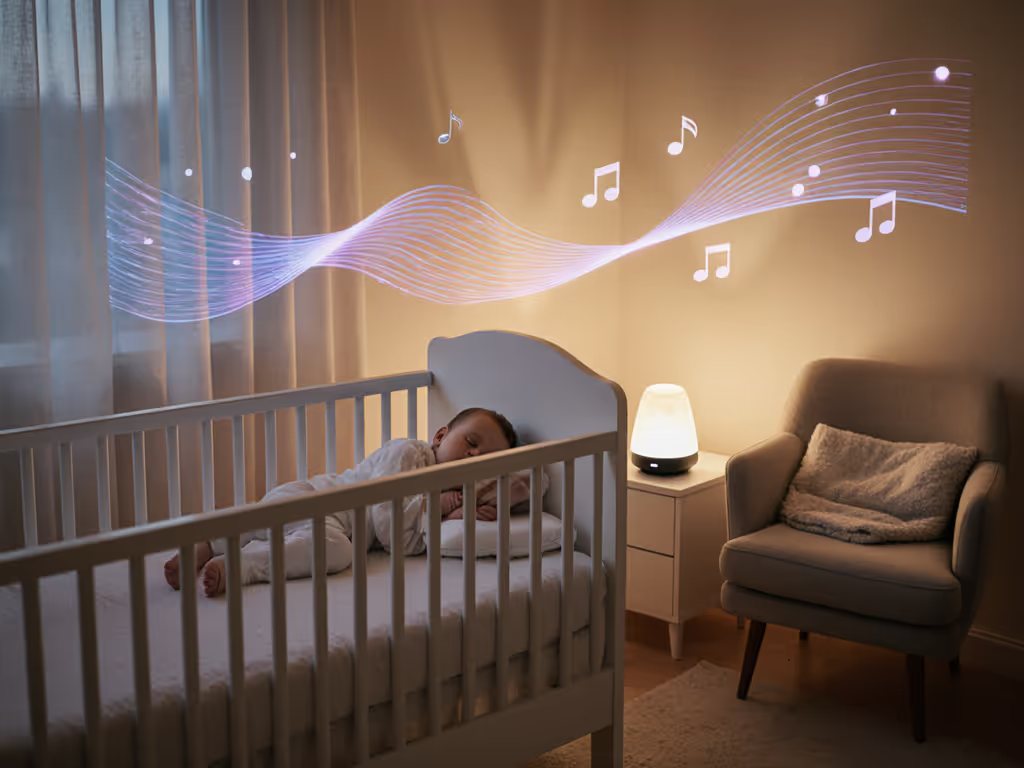
7 Essential Types of White Noise for Babies Explained

Did you know that more than half of new parents struggle with frequent baby sleep disruptions due to background noise? Reliable sleep is not just a wish for exhausted families. It directly supports healthy growth and emotional stability for your little one. Exploring white noise options can turn bedtime from a stressful ordeal into a calm routine, providing the gentle background sounds that help babies settle, rest longer, and feel secure all night.
Quick Summary
| Takeaway | Explanation |
|---|---|
| 1. White noise improves baby sleep. | It creates a consistent sound environment that helps mask disruptive noises and mimics womb sounds. |
| 2. Use fans for natural white noise. | Fans produce steady sound and help regulate room temperature, assisting babies in falling asleep. |
| 3. Nature sounds can soothe infants. | Rhythmic sounds like rainfall create a calming environment that signals safety and relaxation. |
| 4. Household appliance noise can be comforting. | Hums from appliances like refrigerators provide consistent background noise that masks sudden disturbances. |
| 5. Choose electronic machines carefully. | Opt for devices with multiple sound profiles, low volume settings, and safety features to ensure effective use. |
1. Understanding White Noise and Baby Sleep
White noise is more than just background sound. It is a powerful acoustic tool that can transform your baby's sleep environment by creating a consistent sound landscape that mimics the soothing conditions of the womb.
At its core, white noise works by masking disruptive environmental sounds that might startle or wake your infant. Think of it like an acoustic shield that blocks out sudden noises from household activities such as closing doors, conversations, or kitchen sounds. By generating a steady sound spectrum, white noise helps create a stable auditory environment that can significantly improve your baby's sleep quality.
Research suggests white noise is particularly effective because it closely replicates the ambient sounds babies experienced before birth. Inside the womb, infants were constantly surrounded by a blend of muffled sounds including maternal heartbeat, blood flow, and external noises. White noise essentially recreates this familiar soundscape, providing a sense of security and comfort.
Practically speaking, introducing white noise can help babies:
- Fall asleep faster
- Stay asleep longer
- Reduce nighttime wake ups
- Feel more relaxed in their sleeping environment
"White noise mimics the consistent sounds babies hear during pregnancy, creating a calming acoustic environment." - Infant Sleep Specialists
When using white noise, remember two critical guidelines. First, keep the volume moderate (around 50 decibels or lower). Second, place sound machines at least 7 feet away from your baby's sleeping area to protect their developing hearing. These simple steps ensure you harness the benefits of white noise while prioritizing your infant's auditory health.
Understanding white noise is about recognizing it as more than just background sound. It is a scientifically supported sleep strategy that can make a meaningful difference in your baby's rest and overall comfort.
2. Classic Fan Noise: Gentle Consistency
Fan noise represents one of the most accessible and natural forms of white noise for babies. It provides a simple yet effective acoustic solution for creating a peaceful sleep environment right in your own home.
Consistent sound generation is the hallmark of fan noise. Unlike random household sounds that can startle infants, fans produce a steady rhythmic background noise that helps mask unexpected audio disruptions. The continuous airflow creates a predictable sound pattern that can quickly become a sleep cue for your baby.
The beauty of fan noise lies in its simplicity and dual functionality. Not only does it generate soothing white noise, but it also provides gentle air circulation that can help regulate room temperature. This makes fans an excellent multitasking sleep aid for infants.
Practical considerations for using fan noise include:
- Position the fan at least 7 feet away from the baby's crib
- Use oscillating settings for broader sound distribution
- Select a fan with a quiet motor to prevent abrupt sound variations
- Maintain consistent fan speed during sleep periods
"Household fans offer a natural and effective white noise solution that babies find comforting." - Pediatric Sleep Research
While fan noise works wonderfully for many families, it is important to monitor your specific baby's response. Some infants might find certain fan frequencies more soothing than others. Observe your baby's reactions and adjust accordingly.
Remember that fan noise is not just about sound. It is about creating a predictable, calm environment that signals to your baby that it is time to rest. The gentle whoosh becomes a sonic lullaby that can help transform bedtime from a challenging experience to a peaceful transition.
3. Nature Sounds: Calming Rain and Ocean Waves
Nature sounds represent a sophisticated approach to white noise that goes beyond simple sound generation. These acoustic landscapes offer babies a rich auditory experience that can transform their sleep environment into a tranquil sanctuary.
Rhythmic natural soundscapes like rainfall and ocean waves are particularly effective for infant sleep. These sounds mimic the fluid motion and consistent patterns babies experienced in the womb. The gentle percussion of raindrops or the steady rhythm of waves creates a predictable sonic environment that can quickly soothe and calm an infant.
The psychological impact of nature sounds is rooted in our evolutionary response to environmental acoustics. Soft rain or rolling waves signal safety and relaxation. For babies, these sounds communicate a sense of security similar to the muffled sounds they heard before birth. This acoustic familiarity can help reduce stress and promote deeper sleep cycles.
When introducing nature sounds to your baby's sleep routine, consider these key strategies:
- Start with low volume levels
- Choose recordings with smooth, consistent sound patterns
- Rotate between different nature sounds to prevent audio fatigue
- Observe your baby's response and adjust accordingly
"Natural soundscapes provide a sophisticated approach to infant sleep support." - Pediatric Sleep Specialists
Interestingly, not all nature sounds are created equal. Rainfall tends to have a more consistent frequency compared to ocean waves, which can have more dramatic sound variations. Soft rain sounds often work best for creating a stable acoustic backdrop that helps mask potential household disruptions.
Understanding nature sounds is about recognizing them as more than background noise. They are carefully crafted auditory experiences that can significantly enhance your baby's sleep quality and overall comfort.
4. Household Appliance Noise: Everyday Comfort
Household appliances are unexpected heroes in the world of infant sleep. These familiar machines can transform ordinary background noise into a soothing acoustic environment that helps babies rest more peacefully.
Consistent sound generation is the magic behind household appliance white noise. Devices like refrigerators, air conditioners, and washing machines produce steady sound frequencies that can effectively mask sudden environmental noises. The gentle hum of these appliances creates a predictable acoustic backdrop that can help prevent your baby from being startled awake by unexpected sounds.
The scientific principle is surprisingly simple. When an appliance runs continuously it generates a uniform sound wave that acts as an acoustic buffer. This buffer helps smooth out sharp or irregular noises that might otherwise disrupt your baby's sleep. Think of it like an audio blanket that wraps around your infant creating a protective sound environment.
When leveraging household appliance noise for baby sleep, keep these strategies in mind:
- Position noisy appliances away from the baby's immediate sleeping area
- Maintain a moderate volume level
- Choose appliances with consistent sound profiles
- Experiment with different machines to find the most soothing option
"Everyday household sounds can be powerful tools for creating a calm sleep environment." - Infant Sleep Research Institute
Some parents discover that specific appliances work better than others. A running dishwasher might provide more consistent noise than a washing machine with multiple cycle variations. Refrigerators often generate a steady low frequency hum that many babies find particularly soothing.
Understanding household appliance noise is about recognizing the potential of everyday sounds. These familiar mechanical rhythms can become powerful allies in your baby's sleep routine transforming potential disruptions into a comforting acoustic landscape.
5. Heartbeat and Womb Sounds: Familiar Safety
Heartbeat sounds represent the most primal and intimate form of white noise for infants. These rhythmic audio signals recreate the most fundamental acoustic experience of prenatal life transforming them into a powerful sleep support tool.
Neurological familiarity drives the effectiveness of heartbeat and womb sounds. During pregnancy, babies are continuously surrounded by a rich soundscape of maternal bodily functions. The steady 60 to 100 beats per minute rhythm of a heartbeat becomes a fundamental audio reference point for newborns. This sonic memory provides an immediate sense of security and comfort when replicated through specialized white noise devices.
Scientific research suggests that these sounds trigger deep neurological responses. The consistent rhythmic pattern activates neural pathways associated with safety and relaxation. For babies who have recently transitioned from the protected womb environment, these sounds represent an auditory bridge between their prenatal and postnatal experiences.
When introducing heartbeat and womb sounds to your baby's sleep routine, consider these strategic approaches:
- Start with low volume settings
- Select recordings that closely mimic natural heartbeat rhythms
- Use sparingly to prevent overstimulation
- Observe your baby's specific response and adjust accordingly
"Heartbeat sounds are not just noise they are a profound auditory connection to a baby's earliest developmental environment." - Infant Acoustic Research Center
Interestingly, not all heartbeat recordings are equally effective. Medical experts recommend choosing sounds that maintain a steady 60 to 80 beats per minute range matching average maternal heart rates. Recordings that include subtle background womb sounds like soft muffled movements can enhance the acoustic experience.
Understanding heartbeat and womb sounds is about recognizing them as more than simple audio tracks. They are sophisticated neurological triggers that can provide remarkable comfort and support during your baby's critical early development stages.
6. Electronic White Noise Machines: Features and Safety
Electronic white noise machines represent a sophisticated technological solution for infant sleep support. These specialized devices offer precision sound generation beyond what traditional household appliances can provide.
Sound engineering technology enables these machines to produce multiple acoustic profiles with remarkable consistency. Modern white noise machines are not simply sound generators they are carefully designed acoustic tools that can create tailored sound environments specifically optimized for infant sleep patterns.
The most advanced white noise machines include multiple critical features designed to enhance baby sleep experiences. Digital sound processors allow for precise frequency control and seamless sound looping. This means no jarring interruptions or sudden audio shifts that might startle a sleeping infant.
When selecting and using electronic white noise machines, parents should prioritize these key considerations:
- Choose machines with volume control below 50 decibels
- Position devices at least 7 feet away from baby's sleeping area
- Select machines with multiple sound profile options
- Look for devices with automatic shutoff features
- Prioritize machines with smooth sound transitions
"Electronic white noise machines represent a scientifically designed approach to infant sleep support." - Pediatric Sleep Research Institute
Safety remains paramount when introducing electronic sound machines. Experts recommend maintaining low volume levels and avoiding prolonged exposure. The goal is to create a gentle acoustic environment that supports sleep without overwhelming an infant's developing auditory system.
Understanding electronic white noise machines goes beyond simple sound generation. These devices represent a sophisticated intersection of acoustic engineering and infant sleep science providing parents with a powerful tool to support their baby's rest and development.
7. Smartphone Apps: Convenience and Customization
Smartphone white noise apps represent the modern parent's Swiss Army knife for infant sleep support. These digital tools transform your mobile device into a powerful acoustic management system with unprecedented flexibility and control.
Digital sound engineering has revolutionized how parents approach infant sleep environments. Smartphone applications offer an unprecedented range of customizable sound profiles that go far beyond traditional white noise machines. Parents can now fine tune acoustic landscapes with precision impossible just a decade ago.
The true power of these apps lies in their remarkable versatility. Unlike standalone sound machines these digital tools allow real time sound mixing volume adjustment and even recording of personalized sound environments. Some advanced apps include features like gradual volume reduction timer settings and scientifically designed frequency optimizations specifically targeting infant sleep patterns.
When exploring smartphone white noise apps, consider these critical strategies:
- Select apps with pediatrician recommended volume limits
- Choose applications with multiple sound profile options
- Look for apps offering smooth sound transitions
- Prioritize apps with minimal battery drain
- Check for offline playback capabilities
"Smartphone white noise apps provide unprecedented acoustic customization for infant sleep support." - Digital Pediatric Sleep Research Center
Safety remains paramount when using smartphone apps. Experts recommend maintaining low volume levels and avoiding direct speaker placement near an infant. The goal is creating a gentle background soundscape that supports sleep without overwhelming developing auditory systems.
Understanding smartphone white noise apps goes beyond simple sound generation. These digital tools represent a sophisticated intersection of mobile technology and infant sleep science offering parents an adaptive powerful resource for creating optimal sleep environments.
Below is a comprehensive table summarizing the various white noise options for improving infant sleep, including key strategies and benefits.
| Option | Description & Implementation | Benefits/Outcomes |
|---|---|---|
| White Noise | Mimics womb sounds by masking disruptions; keep volume below 50 decibels and device 7 feet away. | Faster sleep onset, longer sleep durations, fewer wake-ups. |
| Fan Noise | Provides steady sound with air circulation; use oscillating settings and quiet motors. | Comforting, natural, dual functionality for temperature control. |
| Nature Sounds | Rhythmic sounds like rain/ocean; start with low volume, rotate sounds. | Calms and reduces stress, replicates womb-like environment, promotes deep sleep. |
| Household Appliances | Uses consistent sounds from refrigerators, air conditioners; maintain moderate volume. | Provides familiar and effective masking of sudden noises. |
| Heartbeat & Womb Sounds | Imitates maternal heartbeat; use recordings sparingly at low volume. | Triggers safety and relaxation responses, links pre- and postnatal environments. |
| Electronic White Noise Machines | Offers multiple sound profiles; position machines safely with volume control below 50 decibels. | Scientifically designed, customizable, maintains consistent transitions. |
| Smartphone Apps | Customizable sound landscapes with pediatrician-approved settings; ensure minimal battery drain and offline capability. | Adaptive, powerful, provides top-tier acoustic customization options. |
Find the Perfect White Noise Solution to Comfort Your Baby
Struggling to create a soothing sleep environment for your baby with the maze of white noise options like classic fan noise, nature sounds, or heartbeat rhythms? The article highlights common challenges new parents face such as keeping volume safe, choosing the right sound frequency, and finding consistent white noise that best mimics the womb. Your goal is clear: help your baby fall asleep faster and stay peacefully asleep longer while protecting their delicate hearing.
Our Acoustic Lab for Little Ears understands these concerns deeply. We combine lab-measured decibel profiles with real-home testing to offer environment-specific recommendations that match your baby's unique needs. Discover how electronic white noise machines and carefully selected sounds can transform bedtime into a calm, secure ritual. Don’t wait for restless nights to wear down your family. Explore expert-tested options now on our website and take the first step toward better sleep for your little one.
Frequently Asked Questions
What is white noise and how does it help babies sleep?
White noise is a consistent sound that masks disruptive noises in the environment. It creates a soothing auditory backdrop that helps babies fall asleep faster and stay asleep longer by mimicking the soundscape of the womb.
How can I safely use white noise for my baby's sleep?
To use white noise safely, keep the volume at or below 50 decibels and position the sound source at least 7 feet away from your baby's sleeping area. This approach ensures you provide the soothing effects of white noise without overwhelming your infant's developing hearing.
What types of white noise are best for calming my baby?
The best types of white noise for babies include fan noise, nature sounds, household appliance noise, and heartbeat sounds. Experiment with these options to find which one your baby responds to most positively, as individual preferences can vary.
How do I choose the right volume for white noise?
Start with a low volume, gradually adjusting until you find a comfortable setting, generally recommended to be below 50 decibels. Monitoring your baby's responses can help you determine the optimal volume for their comfort and sleep quality.
Can I use smartphone apps for white noise?
Yes, smartphone apps can effectively provide white noise with customizable sound profiles tailored to your baby's sleep needs. Select apps that have pediatrician-recommended volume limits and multiple sound options to enhance your baby's sleeping environment.
How often should I use white noise during my baby's sleep routine?
It's best to use white noise consistently during sleep time to create a familiar auditory environment for your baby. Aim to include it in their sleep routine every time they go to sleep to reinforce the calming association.



